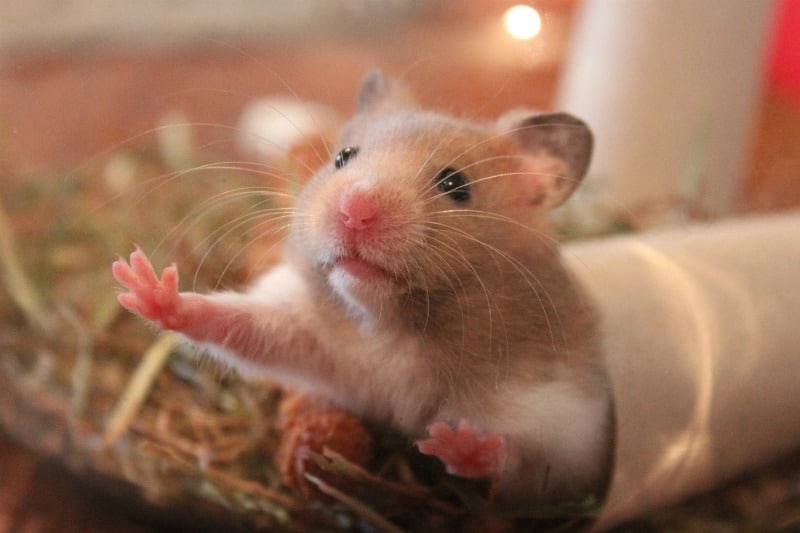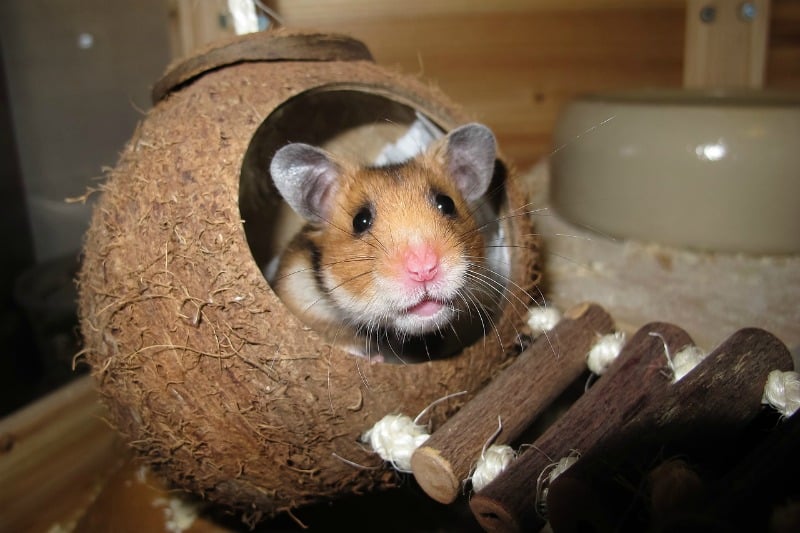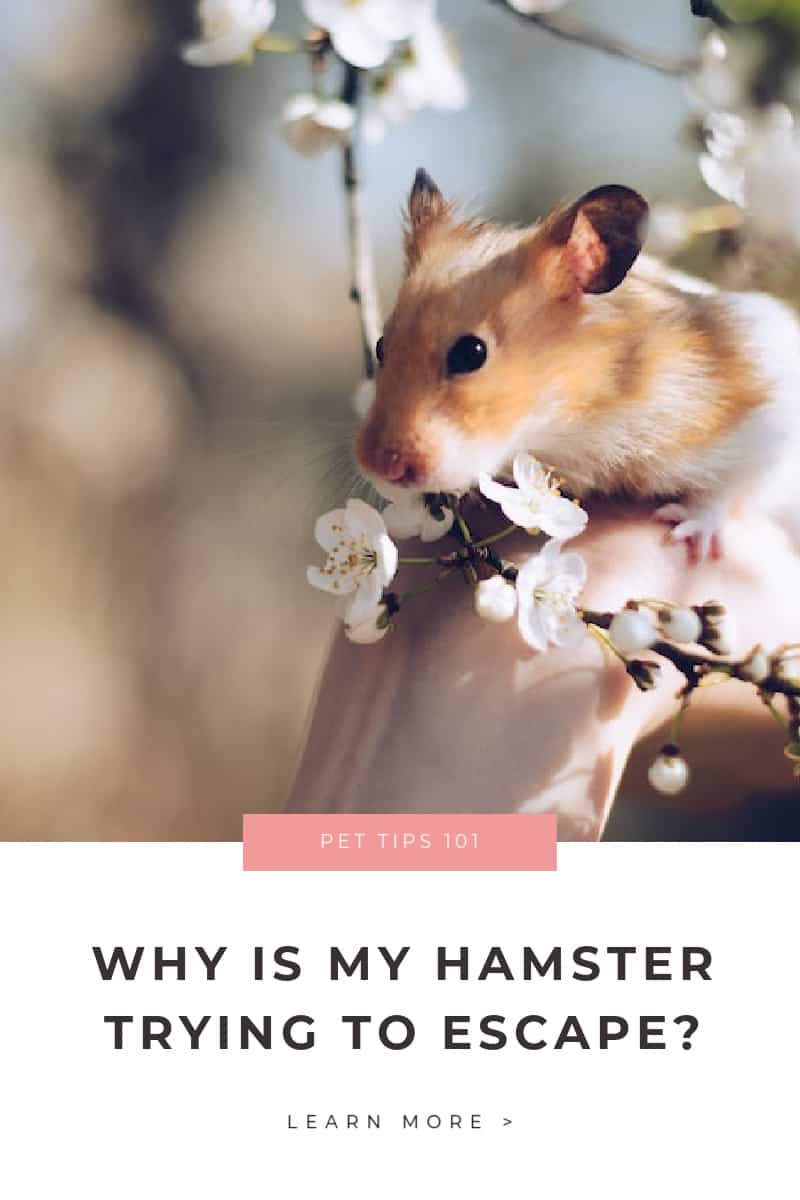Last Updated on April 8, 2024 by ellen
Why does my hamster try to escape? Learn more about why your pet hamster is trying to get out of their hamster cage.
Posts may be sponsored. This post contains affiliate links, which means I will make a commission at no extra cost to you should you click through and make a purchase. As an Amazon Associate I earn from qualifying purchases.
Table of Contents
Hamster Trying to Escape
Hamster owners are probably wondering why it seems like their hamster desperately wants to get out of their cage. Here are a few things to consider when caring for these popular pets.
What does it mean when my hamster climbs the cage?
It can mean a few different things. Your hamster may be trying to explore and find new places or objects to play with, as hamsters are curious creatures by nature. They also love heights and climbing, so they could just be getting some exercise that way.
The first thing to do is to make sure they have enough space. If they need more space, consider a bigger enclosure so you have room for a few more toys.
Are they trying to escape?
In most cases, no – your pet hamster isn’t trying to escape. They are likely trying to find a higher vantage point, or they may just be bored and want something new.
However, if you notice that your hamster is getting overly frustrated when trying to climb their cage, it could be a sign that they need more space. Hamsters do best in spacious cages that offer plenty of room to explore and climb.
What can I do?
If you think your hamster’s cage is too small, it may be time to upgrade its living situation. Choose a larger cage with plenty of hamster toys, tunnels, and other objects for them to explore. Consider a hamster wheel and make sure they have enough food.
You can also add tall structures like ladders or shelves that give your pet a chance to climb. Additionally, make sure you’re giving your hamster enough exercise time outside of its cage for additional stimulation.
Learn how to bond with your hamster.
Overall, most hamsters are just trying to get some mental and physical stimulation when they try to escape from their cages. However, if you feel like the situation is serious and they are truly trying to break out, it may be time for an upgrade to a bigger cage. With the right environment and plenty of exercise, your hamster will stay happy and content in their hamster cage.
Do they have enough food?
Another factor to consider is that your hamster may be trying to escape because they are hungry. Make sure you’re providing them with a balanced diet and plenty of fresh food and water so they don’t feel the need to go out searching for something else.
In addition, if you notice some food hoarding or eating large amounts quickly, this could be a sign that they need more nutrition. Make sure to consult an expert if you’re concerned about your pet’s diet.
Finally, keep in mind that hamsters are nocturnal animals and may be more active during the evening than during the day. Pay attention to their activity times and provide them with enough stimulation for nighttime play. With the right environment, your hamster can happily stay in their cage and won’t feel the need to escape.
What should I have for my hamster?
- Hamster cage
- Water bottle
- Chew toys
- Toys to climb on
- Hamster wheel
- Halo Small Pet Ball Carrier
Let them out of the cage
If you want your hamster to get some fresh air, you can take them outside in a carrier. Put the carrier on the ground in a shady spot.
Ensure the carrier has good ventilation, so your hamster doesn’t get too hot. And check that the carrier is secure so your hamster can’t escape. Your best option is the Halo Small Pet Ball Carrier.
Hamster owners give this portable hamster ball excellent reviews in helping bored hamsters.
What are the signs of an unhappy hamster?
There are a few signs that your hamster may be unhappy in their cage. They may appear lethargic or disinterested in their toys, and they may prefer to spend more time sleeping than playing.
Additionally, they may be trying to escape more frequently than usual, or they could become aggressive toward humans and other animals. If you notice any of these signs, it’s important to evaluate your hamster’s living situation and make sure they are getting the proper stimulation and care.
Providing a safe, comfortable, and stimulating environment for your hamster is essential to their health and happiness. With the right setup, you can ensure that your pet will be content – no matter how hard they try to escape! Hamster wheels are a great option that hamsters love.
If you have a hamster trying to escape, consider your hamster’s environment. They are active animals and need their own space so they don’t feel confined.
Make sure they don’t feel threatened by other pets like cats and dogs in the house. Glass walls may make them seem vulnerable.
How do I stop my hamster from trying to escape?
The best way to stop your hamster from trying to escape is by making sure they are in an appropriate-sized cage that provides plenty of space, toys, tunnels, and other objects for them to explore and play with.
Additionally, make sure you’re offering your pet enough exercise time outside of their cage so they can stay stimulated. If all else fails, you can also try using a larger exercise wheel to keep them entertained. Finally, pay attention to the signs of an unhappy hamster and make sure they are getting the proper care and stimulation they need.
Keep your hamster stimulated by taking him outside in a Halo Small Pet Ball Carrier. This is a safe environment that will make your hamster feel like they have more room to explore. Many owners use this as a way to get daily exercise for bored hamsters.
If you take these steps, you can help ensure that your pet stays content and happy in their cage – without having to worry.
Related Reading
- First hamster supplies
- Can I take my hamster outside?
- Fun toys for hamsters
- Do indoor rabbits need bedding?

Ellen runs a small pet sitting business in southern Vermont. She has experience with a variety of small animals, dogs and cats. She has also cared for ducks, chickens and rabbits. Combined, she has over 20 years of experience in pet care and pet sitting.





